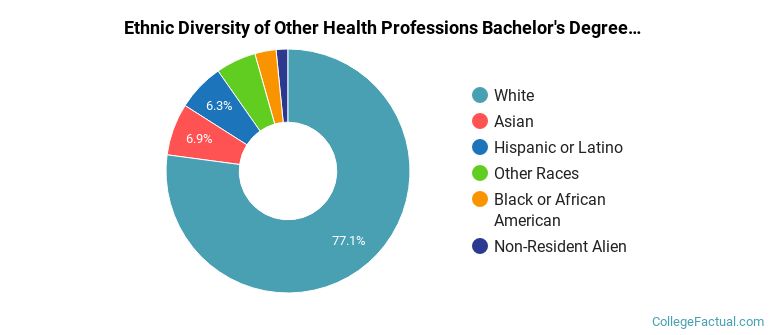 by our College Data Analytics Team
by our College Data Analytics TeamWe've gathered data and other essential information about the program, such as the average salary of graduates, ethnicity of students, how many students graduated in recent times, and more. In addition, we cover how Quinnipiac ranks in comparison to other schools with health professions programs.
Go directly to any of the following sections:
Quinnipiac is in the top 10% of the country for health professions. More specifically it was ranked #9 out of 100 schools by College Factual. It is also ranked #1 in Connecticut.
| Ranking Type | Rank |
|---|---|
| Best Other Health Professions Bachelor’s Degree Schools | 3 |
| Best Other Health Professions Schools | 9 |
During the 2021-2022 academic year, Quinnipiac University handed out 319 bachelor's degrees in other health professions. This is a decrease of 10% over the previous year when 353 degrees were handed out.
In 2022, 9 students received their master’s degree in health professions from Quinnipiac. This makes it the #27 most popular school for health professions master’s degree candidates in the country.
Health Professions majors who earn their bachelor's degree from Quinnipiac go on to jobs where they make a median salary of $31,115 a year. Unfortunately, this is lower than the national average of $38,492 for all health professions students.

While getting their bachelor's degree at Quinnipiac, health professions students borrow a median amount of $85,401 in student loans. This is higher than the the typical median of $32,546 for all health professions majors across the country.

The typical student loan payment of a bachelor's degree student from the health professions program at Quinnipiac is $1,047 per month.
In 2022-2023, the average part-time undergraduate tuition at Quinnipiac was $1,160 per credit hour for both in-state and out-of-state students. Information about average full-time undergraduate tuition and fees is shown in the table below.
| In State | Out of State | |
|---|---|---|
| Tuition | $50,400 | $50,400 |
| Fees | $2,690 | $2,690 |
| Books and Supplies | $1,100 | $1,100 |
| On Campus Room and Board | $16,470 | $16,470 |
| On Campus Other Expenses | $2,660 | $2,660 |
Learn more about Quinnipiac tuition and fees.
During the 2021-2022 academic year, 319 health professions majors earned their bachelor's degree from Quinnipiac. Of these graduates, 17% were men and 83% were women.

The majority of the students with this major are white. About 77% of 2022 graduates were in this category.
The following table and chart show the ethnic background for students who recently graduated from Quinnipiac University with a bachelor's in health professions.

| Ethnic Background | Number of Students |
|---|---|
| Asian | 22 |
| Black or African American | 9 |
| Hispanic or Latino | 20 |
| White | 246 |
| Non-Resident Aliens | 5 |
| Other Races | 17 |
Quinnipiac does not offer an online option for its health professions bachelor’s degree program at this time. To see if the school offers distance learning options in other areas, visit the Quinnipiac Online Learning page.
Take a look at the following statistics related to the make-up of the health professions majors at Quinnipiac University.
| Related Major | Annual Graduates |
|---|---|
| Nursing | 376 |
| Rehabilitation & Therapeutic Professions | 166 |
| Allied Health Professions | 124 |
| Medicine | 97 |
| Allied Health & Medical Assisting Services | 30 |
More about our data sources and methodologies.